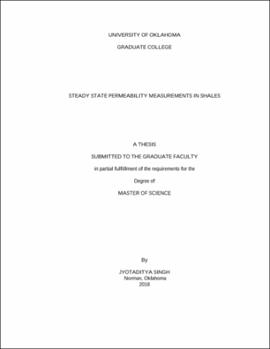| dc.description.abstract | Characterizing matrix permeability in shale formations is vital to determining the long term productivity of a reservoir as well as determining the optimal completion design. Permeability of shales lies in the nanodarcy (six orders of magnitude lower than conventional reservoir formations) range and the pore structure of these rocks is often complex, characterized by mixed wettability and presence of organics.
In this work, we find that the permeability of shales is dependent on the pore fluid used for estimation. Gas (nitrogen) and liquid (dodecane) permeability measurements carried out on the same core plug successively can differ by up to a factor of 4.
Gas and liquid permeability measurements were made on 16 samples from Bakken, Eagle Ford, Wilcox and Wolfcamp formations. Higher TOC samples correspond to higher gas to liquid permeability ratios, exacerbating the effect of pore fluid on the permeability measurement.
Contrary to some published literature, permeability creep, i.e. the change of permeability as a function of time at constant net effective stress has been observed to be insignificant. The laboratory measurement time for permeability tests can thus be minimized. This observation also suggests minimal long-term loss of production due to permeability creep. Creep measurements were made on three samples using nitrogen (on a Bakken sample) and dodecane (Wolfcamp samples). With respect to temperature effects, permeability measurements performed at 158 °F on shale samples from Marcellus, Vaca Muerta and Wolfcamp formations indicates insignificant (<10%) change in permeability compared to room temperature measurements. This seems to suggest that permeability measurements can thus be carried out at room temperature for shale formations, without any significant corrections required for temperature effects.
Two phase flow experiments in shales i.e. flow of oil and gas through water saturated samples reveals the complexity of porous media in shales. Oil (dodecane) showed poor displacement efficiency while flowing through a water saturated Bakken formation sample. NMR results indicate that dodecane does not enter the major connected pore network and is bypassed through alternate flow paths (cracks, fractures etc.). Gas (nitrogen) permeability in a water saturated sample increased with decreasing water saturation. Conducting flow-through experiments with continuous NMR recording can help generate relative permeability curves.
Using MICP (Mercury Injection Capillary Pressure) data, permeability values have been calculated using Kozeny’s, Winland’s, Swanson’s, Kat and Thompson’s and Thomeer’s methods. These estimates are compared to the corresponding steady-state nitrogen permeability measurements performed on core plugs at an effective pressure of 3000 psi. In some cases, MICP measurements can be performed on drill cuttings and require considerably less time than some permeability measurements.
Nineteen samples from the Bakken, Eagle Ford, Marcellus, Utica, Wilcox and Wolfcamp formations have been used in this study. The MICP derived permeability values using some of the aforementioned methods lie within a factor of 4 of the measured slippage-corrected core plug permeability.
MICP permeability estimates, therefore, can be used as a screening tool to determine the zones of interest over which further analysis can be performed. As MICP measurements can be performed on drill cuttings, high permeability zones can be identified even in the absence of cores. Selective zonal analysis after the screening proposed by this study can therefore save time and costs significantly. | en_US |
